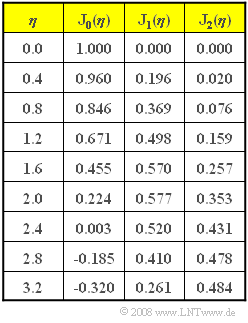Difference between revisions of "Aufgaben:Exercise 3.8: Modulation Index and Bandwidth"
From LNTwww
m |
m (→Questions) |
||
| Line 37: | Line 37: | ||
<quiz display=simple> | <quiz display=simple> | ||
| − | { | + | {Which modulation method is used here? |
|type="()"} | |type="()"} | ||
| − | - | + | - Phase modulation. |
| − | + | + | + Frequency modulation. |
| − | { | + | {What is the modulation index $η_2$ at message frequency $f_{\rm N} = 2 \ \rm kHz$? |
|type="{}"} | |type="{}"} | ||
$η_2 \ = \ $ { 2.4 3% } | $η_2 \ = \ $ { 2.4 3% } | ||
| − | { | + | {What is the carrier amplitude? |
|type="{}"} | |type="{}"} | ||
$A_{\rm T} \ = \ $ { 3 3% } $\ \rm V$ | $A_{\rm T} \ = \ $ { 3 3% } $\ \rm V$ | ||
| − | { | + | {Specify the bandwidth $B_2$ for $f_{\rm N} = 2 \ \rm kHz$ if a distortion factor $K < 1\%$ is desired. |
|type="{}"} | |type="{}"} | ||
$B_2 \ = \ $ { 17.6 3% } $\ \rm kHz$ | $B_2 \ = \ $ { 17.6 3% } $\ \rm kHz$ | ||
| − | { | + | {What is the modulation index $η_4$ at message frequency $f_{\rm N} = 4 \ \rm kHz$? |
|type="{}"} | |type="{}"} | ||
$η_4\ = \ $ { 1.2 3% } | $η_4\ = \ $ { 1.2 3% } | ||
| − | { | + | {What channel bandwidth $B_4$ is now required to ensure $K < 1\%$ ? |
|type="{}"} | |type="{}"} | ||
$B_4 \ = \ $ { 25.6 3% } $\ \rm kHz$ | $B_4 \ = \ $ { 25.6 3% } $\ \rm kHz$ | ||
Revision as of 15:30, 17 March 2022
A harmonic oscillation of the form
- $$q(t) = A_{\rm N} \cdot \cos(2 \pi \cdot f_{\rm N} \cdot t + \phi_{\rm N})$$
is angle-modulated and then the one-sided magnitude spectrum $|S_+(f)|$ is obtained.
- with a message frequency of $f_{\rm N} = 2 \ \rm kHz$ the following spectral lines can be seen with the following weights:
- $$|S_{\rm +}(98\,{\rm kHz})| = |S_{\rm +}(102\,{\rm kHz})| = 1.560\,{\rm V}\hspace{0.05cm},$$ $$|S_{\rm +}(96\,{\rm kHz})| = |S_{\rm +}(104\,{\rm kHz})| = 1.293\,{\rm V}\hspace{0.05cm},$$
- $$ |S_{\rm +}(94\,{\rm kHz})| = |S_{\rm +}(106\,{\rm kHz})| = 0.594\,{\rm V}\hspace{0.05cm}.$$
- Further spectral lines follow each with frequency spacing $f_{\rm N} = 2 \ \rm kHz$, but are not given here and can be ignored.
- If one increases the message frequency to $f_{\rm N} = 4 \ \rm kHz$, there occur dominant lines
- $$|S_{\rm +}(100\,{\rm kHz})| = 2.013\,{\rm V}\hspace{0.05cm},$$
- $$|S_{\rm +}(96\,{\rm kHz})|\hspace{0.2cm} = |S_{\rm +}(104\,{\rm kHz})| = 1.494\,{\rm V}\hspace{0.05cm},$$
- $$ |S_{\rm +}(92\,{\rm kHz})|\hspace{0.2cm} = |S_{\rm +}(108\,{\rm kHz})| = 0.477\,{\rm V},$$
- as well as further, negligible Dirac lines with spacing $f_{\rm N} = 4 \ \rm kHz$.
Hints:
- This exercise belongs to the chapter Frequency Modulation.
- Reference is also made to the chapter Phase Modulation and particularly to the section Signal characteristics with frequency modulation.
Questions
Solution
(1) Es handelt sich um eine Frequenzmodulation ⇒ Antwort 2.
- Bei Phasenmodulation würden sich die Gewichte der Diraclinien bei der Frequenzverdopplung nicht ändern.
(2) Die angegebene Spektralfunktion lässt aufgrund von Symmetrieeigenschaften auf die Trägerfrequenz $f_{\rm T} = 100 \ \rm kHz$ schließen.
- Da bei $f_{\rm N} = 2 \ \rm kHz$ die Spektrallinie bei $f_{\rm T} = 100 \ \rm kHz$ verschwindet, ist $η_2 \hspace{0.15cm}\underline { ≈ 2.4}$ zu vermuten.
- Eine Kontrolle der weiteren Impulsgewichte bestätigt das Ergebnis:
- $$\frac { |S_{\rm +}(f =102\,{\rm kHz})|}{ |S_{\rm +}(f =104\,{\rm kHz})|} = 1.206,\hspace{0.2cm} \frac { {\rm J}_1(2.4)}{ {\rm J}_2(2.4)}= 1.206 \hspace{0.05cm}.$$
(3) Die Gewichte der Diraclinien bei $f_{\rm T} + n · f_{\rm N}$ lauten allgemein:
- $$D_n = A_{\rm T} \cdot { {\rm J}_n(\eta)} \hspace{0.3cm}\Rightarrow \hspace{0.3cm} D_1 = A_{\rm T} \cdot { {\rm J}_1(\eta)}\hspace{0.3cm}\Rightarrow \hspace{0.3cm} A_{\rm T} = D_1/{\rm J}_1(η) = 1.560\ \rm V/0.520\hspace{0.15cm}\underline { = 3 \ V}.$$
(4) Mit der Forderung $K < 1\%$ gilt folgende Faustformel (Carson–Regel):
- $$B_{\rm 2} = 2 \cdot f_{\rm N} \cdot (\eta +2) \hspace{0.15cm}\underline {= 17.6\,{\rm kHz}}\hspace{0.05cm}.$$
- Somit stehen dem Empfänger die Fourierkoeffizienten $D_{–4}$, ... , $D_4$ zur Verfügung.
(5) Bei Frequenzmodulation gilt allgemein:
- $$\eta = \frac{K_{\rm FM} \cdot A_{\rm N}}{ \omega_{\rm N}} \hspace{0.05cm}.$$
- Durch Verdopplung der Nachrichtenfrequenz $f_{\rm N}$ wird also der Modulationsindex halbiert: $η_4 = η_2/2\hspace{0.15cm}\underline { = 1.2}$.
(6) Die für $K < 1\%$ erforderliche Kanalbandbreite ergibt sich nach gleicher Rechnung wie in der Teilaufgabe (4) zu
- $$B_4 = 3.2 · 8\ \rm kHz \hspace{0.15cm}\underline {= 25.6 \ \rm kHz}.$$
- Aufgrund des nur halb so großen Modulationsindex' genügt es für die Begrenzung des Klirrfaktors auf $1\%$, die Fourierkoeffizienten $D_{–3}$, ... , $D_3$ zu übertragen.
